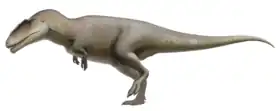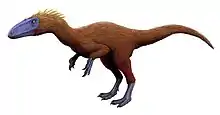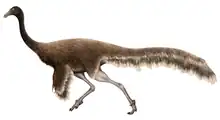Suchosaurus
Suchosaurus (meaning "crocodile lizard") is a spinosaurid dinosaur from Cretaceous England and Portugal, originally believed to be a genus of crocodile. The type material, consisting of teeth, was used by British palaeontologist Richard Owen to name the species S. cultridens in 1841. Later in 1897, French palaeontologist Henri-Émile Sauvage named a second species, S. girardi, based on two fragments from the mandible and one tooth discovered in Portugal. Suchosaurus is possibly a senior synonym of the contemporary spinosaurid Baryonyx, but is usually considered a dubious name due to the paucity of its remains, and is considered an indeterminate baryonychine. In the Wadhurst Clay Formation of what is now southern England, Suchosaurus lived alongside other dinosaurs, as well as plesiosaurs, mammals, and crocodyliforms.
| Suchosaurus | |
|---|---|
 | |
| Holotype tooth of S. cultridens seen from two angles | |
| Scientific classification | |
| Domain: | Eukaryota |
| Kingdom: | Animalia |
| Phylum: | Chordata |
| Clade: | Dinosauria |
| Clade: | Saurischia |
| Clade: | Theropoda |
| Family: | †Spinosauridae |
| Subfamily: | †Baryonychinae |
| Genus: | †Suchosaurus Owen, 1841 |
| Type species | |
| †Suchosaurus cultridens Owen, 1841 | |
| Species | |
| Synonyms | |
History of discovery
In about 1820, British palaeontologist Gideon Mantell acquired teeth discovered near Cuckfield in the Wadhurst Clay of East Sussex, part of a lot with the present inventory number BMNH R36536. In 1822, he reported these, after an identification by William Clift, as belonging to crocodiles.[1] In 1824, the teeth were mentioned and illustrated by Georges Cuvier, representing the first fossil illustration of a spinosaurid dinosaur (though this group wouldn't be recognized for nearly another century).[2] In 1827 Mantell described additional teeth, pointing out the similarities to the crocodilians Teleosaurus and Gavialis.[3] One of these teeth is the present specimen BMNH R4415, others are part of BMNH R36536.
In 1841, British palaeontologist Richard Owen named, based on BMNH R36536 as a syntype series, a subgenus Crocodylus (Suchosaurus) with as type species Crocodylus (Suchosaurus) cultridens.[4] The subgeneric name was derived from Greek σοῦχος, souchos, the name of the Egyptian crocodile god Sobek. This reflected the presumed taxonomic affinities; at the time the crocodile-like snouts of spinosaurids were not known. The specific name is derived from Latin culter, "dagger", and dens, "tooth", in reference to the elongated form of the teeth. In 1842, Owen again mentioned the taxon as a subgenus,[5] subsequently he and other workers would use it as a full genus Suchosaurus. In 1842 and 1878 Owen referred some vertebrae (backbones) to Suchosaurus,[6] but these were later identified by Richard Lydekker as likely belonging to ornithischian dinosaurs instead.[7] In 1884, Owen indicated a tooth as "Suchosaurus leavidens" in a caption,[8] this is usually seen as a lapsus calami (or "slip of the pen") because this species is not further mentioned.
In 1897, French palaeontologist Henri-Émile Sauvage named a second species: Suchosaurus girardi, based on two jaw fragments (specimen MG324) and a tooth, found in the Papo Seco Formation of Portugal by Swiss-Portuguese geologist Paul Choffat. The specific name honours French geologist Albert Girard.[9] The tooth was considered lost but was rediscovered and in 2013 reported as specimen MNHN/UL.I.F2.176.1, part of remains recovered after a fire in 1978.[10]
During the nineteenth and most of the twentieth century, Suchosaurus was usually considered to have been some obscure crocodilian, perhaps belonging to the Pholidosauridae.[11] Single comparable teeth discovered in England were referred to the genus.[7] However, when publishing a redescription of Baryonyx in 1998, British palaeontologist Angela Milner realised that the teeth of that spinosaurid dinosaur were extremely similar to those of Suchosaurus. In 2003, she suggested both genera represented one and the same animal.[12] An identity would imply the name Suchosaurus has priority. However, the Suchosaurus teeth are also indistinguishable from those of Cristatusaurus and Suchomimus, making it an indeterminate baryonychine.

In 2007, French palaeontologist Eric Buffetaut considered the teeth of S. girardi very similar to those of Baryonyx (and S. cultridens) except for the stronger development of the ribs (lengthwise ridges) on the tooth crown, suggesting that the remains belonged to the same genus. Buffetaut agreed with Milner that the teeth of S. cultridens were almost identical to those of B. walkeri, but with a ribbier surface. The former taxon might be a senior synonym of the latter (since it was published first), depending on whether the differences were within a taxon or between different ones. According to Buffetaut, since the holotype specimen of S. cultridens is one worn tooth and that of B. walkeri is a skeleton it would be more practical to retain the newer name.[13] In 2011, Portuguese palaeontologist Octávio Mateus and colleagues agreed that Suchosaurus was closely related to Baryonyx, but considered both species in the former genus (Suchosaurus) nomina dubia (dubious names) since their holotype specimens were not considered diagnostic (lacking distinguishing features) and could not be definitely equated with other taxa.[14]
Description

In 2012, American vertebrate palaeontologist Thomas R. Holtz Jr. tentatively estimated Suchosaurus at around 10 metres (33 ft) in length and weighing between 1 and 4 tonnes (1.1 and 4.4 short tons).[15][16] And in 2016, Spanish palaeontologists Molina-Pérez and Larramendi estimated S. cultridens at approximately 8.6 m (28 ft) long, 2.15 m (7.1 ft) tall at the hips and weighing 1.4 t (1.5 short tons).[17] The teeth of Suchosaurus girardi were curved, oval in cross section, and had tall roots that were one and a half times taller than the crown. Its teeth, like some other spinosaurids, bore flutes (lengthwise grooves), in S. girardi, there were eight flutes on the lingual side (which faced the inside of the mouth), and four less distinct flutes on the labial side (which faced the outside of the mouth). The tooth enamel, or outermost layer, had a microscopic wrinkled texture.[14]
Palaeoecology

The Wadhurst Clay Formation, part of the Wealden Group, is dated to the Valanginian stage of the Early Cretaceous Period, about 139.8 to 132.9 million years ago.[18] It consists mainly of shales and mudstones.[19] Other dinosaurs that shared this environment with Suchosaurus included the iguanodontians Barilium and Hypselospinus,[20] as well as the dubious species Megalosaurus dunkeri and an unnamed maniraptoran.[21][22] They coexisted with the plesiosaur Hastanectes,[23] the crocodyliform Goniopholis[24] and the mammals Loxaulax,[25] Aegialodon,[26] Laolestes,[27] and Spalacotherium.[28]
References
- Mantell, G.A., 1822, The fossils of the South Downs or Illustrations of the Geology of Sussex, London, Rupton Relfe
- Cuvier, G., 1824, Recherches sur les ossemens fossiles, deuxième édition. Dufour & d’Ocagne, Paris. 547 pp
- Mantell, G.A., 1827, Illustrations of the geology of Sussex, London, Lupton Relfe. 92 pp
- Owen, R. (1840–1845). Odontography. London: Hippolyte Baillière, 655 pp, 1–32
- Owen, R., 1842, Report on British fossil reptiles. Part II. Reports of the meetings of the British Association for the Advancement of Science. 11, pp 61-204
- Owen, R., 1878, Monograph on the fossil Reptilia of the Wealden and Purbeck Formations. Supplement VIII, (Goniopholis, Petrosuchus, and Suchosaurus). Palaeontolographical Society Monographs, 32, pp 1-15
- Lydekker, R., 1888, Catalogue of the Fossil Reptilia and Amphibia in the British Museum (Natural History), Cromwell Road, S.W., Part 1. Containing the Orders Ornithosauria, Crocodilia, Dinosauria, Squamata, Rhynchocephalia, and Proterosauria. British Museum of Natural History, London. 309 pp
-
- Owen, R., 1884, A History of British Fossil Reptiles, Volume II. Cassell, London. 224 pp
- Sauvage, H. E. (1897–1898). Vertébrés fossiles du Portugal. Contribution à l’étude des poissons et des reptiles du Jurassique et du Crétacique. Lisbonne: Direction des Travaux géologiques du Portugal, 46p
- Malafaia, E.; Ortega, F.; Escaso, F.; Mocho, P., 2013, "Rediscovery of a lost portion of the holotype of Suchosaurus girardi (Sauvage, 1897-98), now related to the spinosaurid theropod Baryonyx", In: Torcida Fernández-Baldor, F.; Huerta, P. (Eds.). Abstract book of the VI International Symposium about Dinosaurs Palaeontology and their Environment pp 82-84
- Buffetaut, E., 2010, "Spinosaurs before Stromer: Early finds of spinosaurid dinosaurs and their interpretations", Geological Society, London, Special Publications. 343, pp 175-188
- Milner, A., 2003, "Fish-eating theropods: A short review of the systematics, biology and palaeobiogeography of spinosaurs". In: Huerta Hurtado and Torcida Fernandez-Baldor (eds.). Actas de las II Jornadas Internacionales sobre Paleontologýa de Dinosaurios y su Entorno (2001). pp 129-138
- Buffetaut, E. (2007). "The spinosaurid dinosaur Baryonyx (Saurischia, Theropoda) in the Early Cretaceous of Portugal." Geological Magazine, 144(6): 1021-1025. doi:10.1017/S0016756807003883
- Mateus, O.; Araújo, R.; Natário, C.; Castanhinha, R. (2011). "A new specimen of the theropod dinosaur Baryonyx from the early Cretaceous of Portugal and taxonomic validity of Suchosaurus" (PDF). Zootaxa. 2827. 2827: 54–68. doi:10.11646/zootaxa.2827.1.3.
- Holtz, Thomas R. Jr. (2011) Dinosaurs: The Most Complete, Up-to-Date Encyclopedia for Dinosaur Lovers of All Ages, Winter 2010 Appendix.
- Holtz, T. R. Jr. (2014). "Supplementary Information to Dinosaurs: The Most Complete, Up-to-Date Encyclopedia for Dinosaur Lovers of All Ages". University of Maryland. Retrieved 2014-09-05.
- Molina-Peréz & Larramendi (2016). Récords y curiosidades de los dinosaurios Terópodos y otros dinosauromorfos. Barcelona, Spain: Larousse. p. 275. ISBN 9780565094973.
- Hopson, P.M., Wilkinson, I.P. and Woods, M.A. (2010) A stratigraphical framework for the Lower Cretaceous of England. Research Report RR/08/03. British Geological Survey, Keyworth.
- Lake, R.D. & Shepard-Thorn, E.R. (1987) Geology of the country around Hastings and Dungeness: Memoir for 1:50,000 geological sheets 320 and 321. British Geological Survey, London.
- Holtz, T. R.; Molnar, R. E.; Currie, P. J. (2004). "Basal Tetanurae". In Weishampel, D. B.; Dodson, P.; Osmolska, H. (eds.). The Dinosauria (2 ed.). Berkeley: University of California Press. p. 559. ISBN 978-0-520-24209-8.
- Naish, D. and Sweetman, S.C. (2011). "A tiny maniraptoran dinosaur in the Lower Cretaceous Hastings Group: evidence from a new vertebrate-bearing locality in south-east England." Cretaceous Research, 32: 464-471. doi:10.1016/j.cretres.2011.03.001
- Michael W. Maisch (2016). "The nomenclatural status of the carnivorous dinosaur genus Altispinax v. Huene, 1923 (Saurischia, Theropoda) from the Lower Cretaceous of England". Neues Jahrbuch für Geologie und Paläontologie - Abhandlungen. 280 (2): 215–219. doi:10.1127/njgpa/2016/0576.
- Benson, R. B. J.; Ketchum, H. F.; Naish, D.; Turner, L. E. (2012). "A new leptocleidid (Sauropterygia, Plesiosauria) from the Vectis Formation (Early Barremian–early Aptian; Early Cretaceous) of the Isle of Wight and the evolution of Leptocleididae, a controversial clade". Journal of Systematic Palaeontology. 11 (2): 233–250. doi:10.1080/14772019.2011.634444. S2CID 18562271.
- De Andrade, M. B.; Edmonds, R.; Benton, M. J.; Schouten, R. (2011). "A new Berriasian species of Goniopholis (Mesoeucrocodylia, Neosuchia) from England, and a review of the genus". Zoological Journal of the Linnean Society. 163: S66–S108. doi:10.1111/j.1096-3642.2011.00709.x.
- Simpson, G. G. (1928). "A catalogue of the Mesozoic mammalia in the geological department of the British Museum". London: British Museum (Nat Hist).
- Kermack, K. A.; Lees, Patricia M.; Mussett, Frances (1965). "Aegialodon dawsoni, A New Trituberculosectorial Tooth from the Lower Wealden". Proceedings of the Royal Society of London. Series B, Biological Sciences. 162 (989): 535–554. Bibcode:1965RSPSB.162..535K. doi:10.1098/rspb.1965.0055. ISSN 0080-4649. JSTOR 75561. PMID 4378463. S2CID 39141524.
- Foster, J. (2007). "Appendix." Jurassic West: The Dinosaurs of the Morrison Formation and Their World. Indiana University Press. pp. 327-329.
- "Spalacotherium Owen 1854 - Encyclopedia of Life". eol.org. Retrieved 2020-04-21.
External links
- First post of a long discussion of Suchosaurus as a dinosaur and its implications, in the Dinosaur Mailing List Archives


.jpg.webp)












